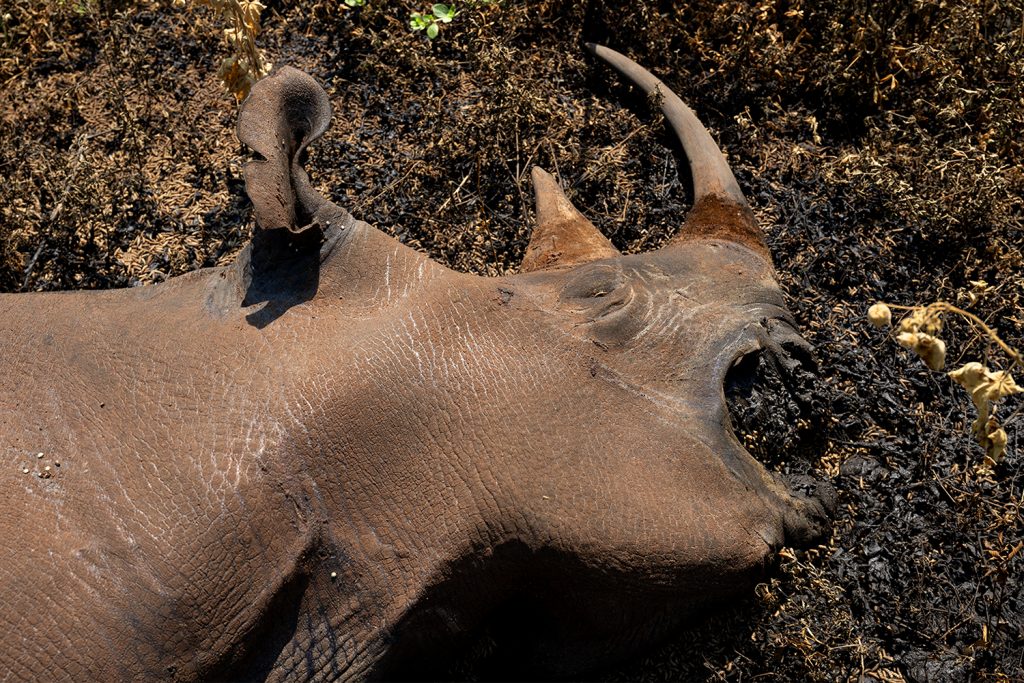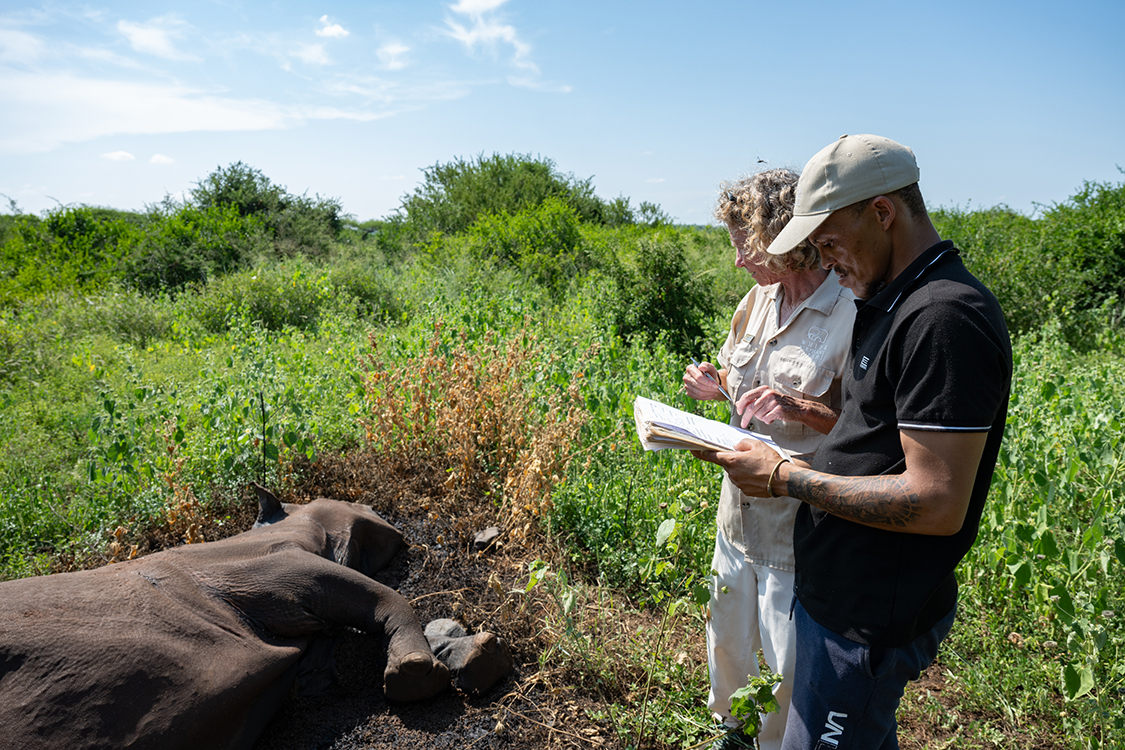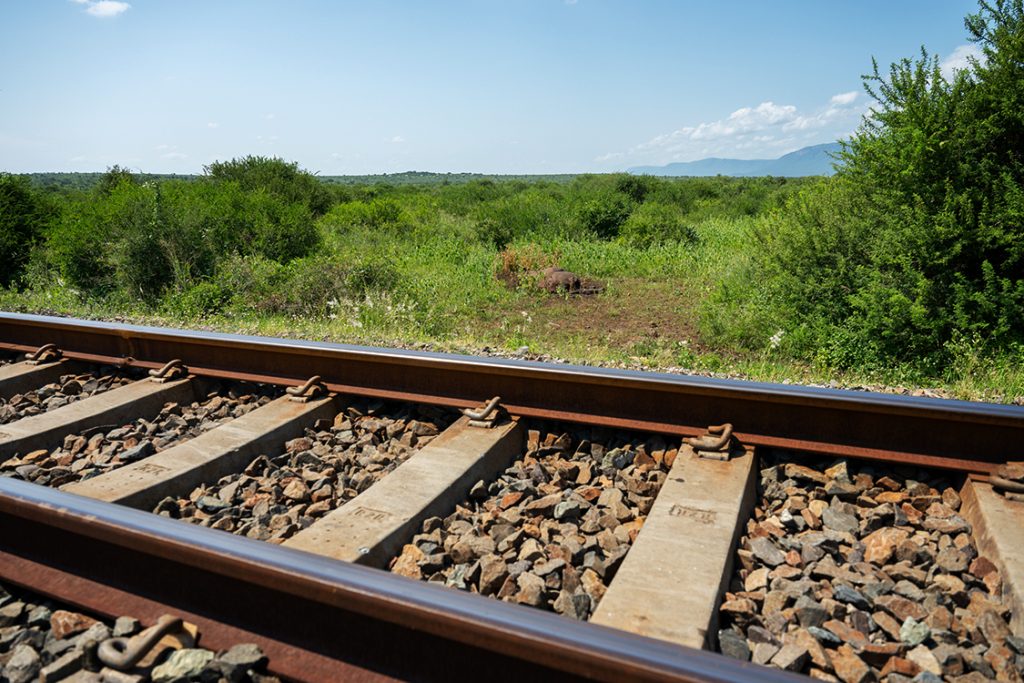"Tracks of Death"
"Another rhino killed on Pongola Game Reserve by Transnet locomotive and a troubling absence of vultures."
Game Reserve On Tuesday, February 4th, I stood alongside the Pongola Game Reserve rangers to document yet another heartbreaking loss. The stench of decay hung thick in the air, clinging to us as we approached the decaying body of a black rhino. Its once powerful form was now grotesque, overtaken by the relentless creep of decomposition, and maggots squirmed through open wounds, feasting on what remained.

While the local ranger and the reserve wildlife monitor were busy trying to identify the rhino and record evidence, I moved carefully around the carcass– every action was driven by the need to document the truth without disturbing the crime scene.
With my camera in hand, I captured every angle—the deep drag marks in the soil, the impact wounds, and the unsettling stillness of a body left to decay.
Kneeling beside the decomposing rhino, I collected some of the maggots and sealed them carefully, a grim but crucial detail that could help estimate the time of death.
Collecting evidence as the first team on the scene is critical, as even the smallest piece of evidence could help us understand the sequence of events. Every piece of evidence mattered. Every detail told a story. And it was our duty to ensure the story was recorded before the elements erased it forever.
This was not an instant kill—this rhino had suffered, its final moments marked by agony and struggle. The evidence was clear: a violent impact had shattered its hip and left leg. Deep drag marks in the dirt told a silent story of pain—the animal had tried to move, to survive, but had collapsed just meters from where the animal had been struck. How long had it lain there, unseen and forgotten? How many more will meet the same fate before action is taken? The railway slicing through Pongola’s wilderness is no longer just a passage for trains; it has become a corridor of death. And unless something changes, this will not be the last tragedy we witness.

A Pattern of Neglect and Destruction
The brutal death of this black rhino is not an isolated tragedy—it is part of a disturbing pattern. In February 2021, a hippo met the same fate, killed on these very tracks. Just months later, in July, several vultures perished after being struck by a train while feeding on the remains of another victim.
In August 2023, a Transnet train ploughed into four white rhinos in the very same reserve. Two were killed instantly, one was gravely injured, and the fourth went missing. On the same day, other wildlife—including a giraffe, wildebeest, a nyala, and several impalas—were also reported dead along the tracks.
“How many more must die before real action is taken?”

The railway, meant for progress, has become a corridor of death, claiming the lives of wildlife with alarming frequency. Conservationists have long warned that these railways pose a lethal risk to wildlife, yet little has been done to enforce speed regulations or implement preventative measures.
This year has begun with a relentless trail of blood on the tracks. On January 21st, a devastating 24 impalas were killed by a speeding train. Then, on February 5th—just hours after we discovered the decomposing black rhino—tragedy struck again. Three adult female buffalos were hit on the railway; two were killed instantly, while the third, gravely injured, had to be euthanised.
Rangers and reserve managers have repeatedly expressed their concerns about Transnet’s failure to slow down when passing through protected areas. Despite a previously agreed-upon speed limit of 40 km/h, reports suggest that some trains are travelling at speeds of 70 km/h or more, turning the railway into a death trap for any animal crossing its path.
This black rhino is not just another casualty but a species teetering on the brink of survival. Listed as critically endangered on the IUCN Red List, every life lost pushes them closer to extinction. With fewer than 5,630 individuals remaining in the wild, each death is not just a statistic but a devastating setback to conservation efforts. Despite all the efforts to protect them, they continue to fall victim —not by poachers this time, but to reckless infrastructure and indifference.
The Vulture Crisis: A Silent Warning
While investigating this tragic loss, the absence of vultures was glaring. According to local veterinarian Dr Heinz, who later assessed the carcass and surrounding area, estimated that the rhino had likely been dead for seven to ten days before being discovered by a local ranger. What struck me, however, was something deeply unsettling—the complete absence of vultures.
A carcass of this size, lying undisturbed for nearly two weeks, should have been a magnet for these critically important scavengers. Instead, there was nothing. No circling birds overhead, no signs of feeding. Just stillness.
This absence of vultures raises another pressing concern- the dwindling vulture population in South Africa and its cascading effects on the ecosystem.
These birds play a vital role in maintaining ecological balance, rapidly consuming carcasses and preventing the spread of disease. The fact that no vultures had arrived at the scene raises alarming questions about their declining numbers in South Africa.
Several species of vultures in the region are critically endangered due to habitat loss, poisoning, and illegal wildlife trade. The lack of vultures at the rhino’s carcass suggests a broader crisis unfolding in the background—one that threatens not only scavenger populations but the ecosystem’s overall health.
If Transnet’s ongoing negligence continues to claim lives at this rate, we could see an irreparable imbalance in local wildlife populations. The rhino’s death is tragic enough, but the missing vultures are a sign of an even deeper problem—one we cannot afford to ignore.
We cannot allow this practice to persist. Transnet must take immediate responsibility and enforce strict speed regulations for its trains passing through wildlife game reserves. Discussions between conservationists and railway authorities must translate into action, not just empty promises.
Additionally, urgent conservation efforts are needed to protect South Africa’s remaining vulture populations before it’s too late.
Every train that speeds through these reserves without accountability is another ticking time bomb for our already fragile wildlife. The black rhino, left to die alone in the bush, and the eerie absence of vultures that should have circled above are both warning signs.
"So the question is: Where does accountability begin and end? Is it the Ministry of Forestry, Fisheries and the Environment? Transnet? Ezemvelo? Or will they all continue to pass the blame while the tracks run red with the blood of the very wildlife they claim to protect?
And just as crucial, what does accountability even look like? Blame games, empty statements, delayed actions, actual enforceable change before another life is lost? Or will heads roll?
For more information please contact:
Leticia Cox / LensTraveller
Investigative Journalist
Email: info@lenstraveller.net
WhatsApp: +27765035329
Subject: MAWANA ELEPHANTS CRISIS
Join LensTraveller On A Journey Of Discovery. Stay updated with the latest travel adventures, inspirations and insights.
*By subscribing you agree to our Terms &Conditions and Privacy & Cookies Policy.
























